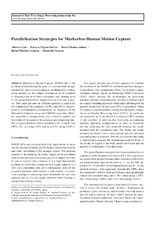Mostrar el registro sencillo del ítem
Parallelization Strategies for Markerless Human Motion Capture
| dc.contributor.author | Cano, Alberto | |
| dc.contributor.author | Yeguas-Bolívar, Enrique | |
| dc.contributor.author | Medina-Carnicer, R. | |
| dc.contributor.author | Ventura Soto, S. | |
| dc.contributor.author | Muñoz-Salinas, Rafael | |
| dc.date.accessioned | 2015-10-15T10:32:56Z | |
| dc.date.available | 2015-10-15T10:32:56Z | |
| dc.date.issued | 2015-10-15 | |
| dc.identifier.uri | http://hdl.handle.net/10396/13002 | |
| dc.description.abstract | Markerless Motion Capture (MMOCAP) is the problem of determining the pose of a person from images captured by one or several cameras simultaneously without using markers on the subject. Evaluation of the solutions is frequently the most time-consuming task, making most of the proposed methods inapplicable in real-time scenarios. This paper presents an efficient approach to parallelize the evaluation of the solutions in CPUs and GPUs. Our proposal is experimentally compared on six sequences of the HumanEva-I dataset using the CMAES algorithm. Multiple algorithm’s configurations were tested to analyze the best trade-off in regard to the accuracy and computing time. The proposed methods obtain speedups of 8× in multi-core CPUs, 30× in a single GPU and up to 110× using 4 GPUs | es_ES |
| dc.format.mimetype | application/pdf | es_ES |
| dc.language.iso | eng | es_ES |
| dc.rights | https://creativecommons.org/licenses/by-nc-nd/4.0/ | es_ES |
| dc.source | Journal of Real-Time Image Processing manuscript No. | es_ES |
| dc.subject | MMOCAP | es_ES |
| dc.title | Parallelization Strategies for Markerless Human Motion Capture | es_ES |
| dc.type | info:eu-repo/semantics/preprint | es_ES |
| dc.rights.accessRights | info:eu-repo/semantics/openAccess | es_ES |

